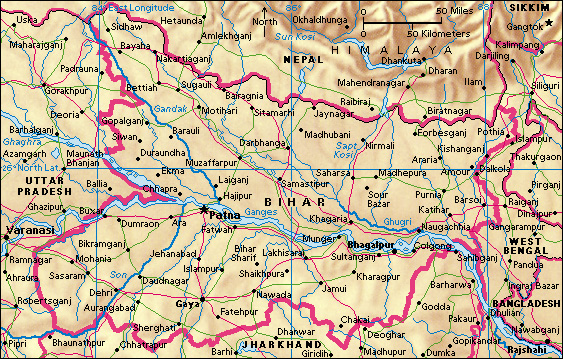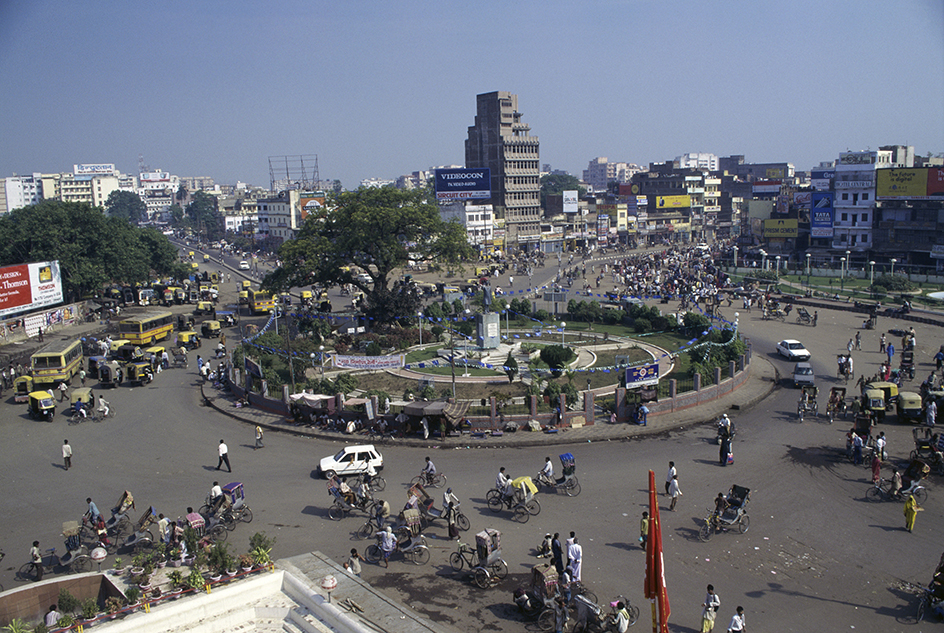Bihar << bee HAHR >> (pop. 104,099,452) is a state in northeastern India. The name Bihar comes from the Hindi word vihara, a Buddhist temple or monastery. The state capital is Patna. The flat plains of the Ganges River, which stretch across the middle of the state, are the main agricultural area.

Bihar is one of India’s most densely populated and poorest states. The state covers an area of 36,357 square miles (94,163 square kilometers) and has a population of over 100 million. In November 2000, a new state called Jharkhand was formed from the southeastern districts of Bihar.
Bihar has one of the largest populations of the Indian states. Much of Bihar’s population is too poor to afford the food, shelter, and medical care they need. Nearly 85 percent of the people of Bihar are Hindus. Muslims, the next largest group, make up over 15 percent of the population. Bihar also has some small ethnic groups known as tribes.
Government.
Bihar has 40 elected members in the Lok Sabha (lower house) and 16 nominated representatives in the Rajya Sabah (upper house) of the Indian national Parliament. The regional head of state is the governor, who is appointed by the president of India to a five-year term. Bihar has a bicameral (two-chambered) state legislature, which meets in Patna. The Vidhan Sabha (lower house) has 243 members, and the Vidhan Parishad (upper house) has 75 members.
At the district level, the chief administrative officer is called the collector. Local administration is in the hands of the gram panchayat (village councils) of elected members. Some panchayat seats are reserved for women.
Economy.
Bihar is mainly an agricultural state. Rice, the main wet-season crop, is the state’s major crop. Other important crops include barley, corn, vegetables, and wheat. Mangoes are also a speciality of Bihar. Bihar is India’s biggest producer of freshwater fish.
Bihar’s former industrial area was in the Chota Nagpur region, which became part of the state of Jharkhand in 2000. Several craft industries remain in Bihar. Madhubani painting is done on handmade paper with traditional vegetable dyes which are mixed with goat’s milk. A special grass called sikki is woven to make brightly colored boxes and baskets. Bihar is also known for its wooden toys, metal figures, and leather goods.

Land.
The broad, flat plains of the Ganges River Valley cover most of Bihar. The Ganges, one of the world’s longest rivers, runs from west to east through the heart of the state. During the monsoon season, it is swollen by heavy rains and by water released by melting snow from the Himalaya.
The Ganges is joined in Bihar by northern tributaries from the Himalaya, such as the Ghaghara, Gandak, and Kosi rivers. The Son River joins the Ganges from the southwest. To the north of the Ganges are old riverbeds, which fill up with water to form chains of lakes during the monsoon. These lakes are an important source of fish.
History.
Archaeologists have found agricultural settlements in Bihar dating from before 2000 B.C. Cities emerged in the area around the 500’s B.C. The ancient Indian state of Magadha dominated the region during this period. The Magadha rulers supported the emerging religions of Buddhism and Jainism. Many places in Bihar are associated with Gautama Buddha—the founder of Buddhism—or with Mahavira—who organized the Jain faith.
Toward the end of the 300’s B.C., a new empire emerged in the Bihar region. Chandragupta Maurya overthrew the last of the Magadha rulers and reigned from about 324 B.C. to about 298 B.C. He laid the foundations of the Mauryan Empire, the first empire to unite most of India under one ruler.
Chandragupta’s grandson was the great emperor Ashoka, who became ruler of all India except the south. Pillars bearing Ashoka’s edicts (messages to his people) and topped with lions facing the four directions of the compass still stand throughout India. After the death of Ashoka in 232 B.C., the Bihar region was ruled by minor clans (families).
The Guptas came to power in the A.D. 300’s. These kings encouraged a flowering of Hindu culture, and the Gupta period became known as India’s golden age. The Guptas expanded their territory and fought off attacks by the Huns. By the 500’s, the Huns overcame Gupta defenses and began conquering much of northern India. A variety of smaller kingdoms controlled the region for the next several hundred years.
Turkic and Afghan invaders arrived in 1197 and defeated Hindu rulers in the region. Muslim political power grew strong in Bihar. Muslim place names, such as Aliganj and Hajipur, remain as evidence of the era of Muslim political dominance.
In the 1700’s, the British East India Company gained control of much of India. The British East India Company and, later, the government of the United Kingdom treated most Indians badly. Most of Bihar’s people became impoverished. Throughout the 1800’s, resistance to British rule increased in Bihar and across India, and nationalist movements and rebellions grew.
After India gained independence in 1947, Bihar became one of the original states. During the later half of the 1900’s, Bihar was one of India’s poorest and most badly administered states. In the 1980’s and 1990’s, violent clashes took place between castes (social groups). Feuds still occur frequently over land ownership and between landlords and their tenants.
A movement to create a new state called Jharkhand from Bihar’s southern districts gained strength in the 1970’s and 1980’s. Bihar’s tribal people, alarmed at the rapid depletion of forests and the threat to their traditional way of life, began to press harder for a new state. In 1995, Bihar’s government created the Jharkhand Area Autonomous Council to provide some self-government for the region. However, elections to the council were not held until 1997.
In August 2000, supporters introduced the Bihar Reorganization Bill, calling for the establishment of a separate state of Jharkhand, to the Lok Sabha. The Lok Sabha passed the bill on Aug. 4, 2000, and the Rajya Sabha passed it on Aug. 11, 2000. Jharkhand was created on Nov. 15, 2000.
